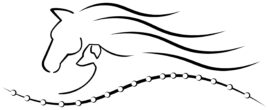What is equine osteopathy
In more populated places like Texas or Arizona, osteopathy is a concept many people are familiar with. However, here in Wyoming and surrounding areas, it is an unfamiliar concept. Since I encounter a fair amount of interest in osteopathy, let me offer a simple outline of what it is.
Osteopathy is a hands-on therapy mobilizing the whole body. We take a whole horse perspective by addressing three vital systems including the parietal system (musculo-skeletal), the cranial-sacral system (cranium, sacrum, and flow of fluid between the two), and the visceral system (organ and surrounding supportive structures). An osteopath’s goal is to find the root of the horse’s problem vs just treating a symptom. Often this root is an immobility or something causing an immobility within the three systems. This can include a fall, impact, or an injury of some kind, dental issues, foot issues, diet, tack fit, or stress. An immobility will cause a cascade of events over time including pain, congestion, behavioral problems, constant stress, or expression of [negative] emotions. By reestablishing mobility in the body, we are helping that animal have optimal performance, vitality, and a new homeostatic balance allowing him to heal, adapt, and compensate for his body and environment. This leads to a happier and healthier horse overall.
So what does an osteopathic session look like?
I start with an evaluation. I test mobility in all three systems making my connections between the three. My connections come from having a solid understanding of the biomechanics of the horse, its neurology, and how these play into the overall vascularity within the body. I then mobilize the three systems where needed. While mobilizing the skeletal system, many people say this looks similar to chiropractic. However, as osteopaths we follow our own techniques and protocols. Throughout the three systems, I use a combination of direct mobilization, indirect mobilization, and light touch techniques. Many times a single session will take care of the problem, but as with anything, there are always exceptions. The founder of Osteopathy, Andrew Taylor Still, D.O. said, “You find it, you fix it, then you leave it alone to let nature do the rest.” This simply means that after a session we let some time go by to allow the body to heal, adapt, and compensate on its own. The last thing an osteopath wants is to become a “crutch” for that body, and take over the vitality by constantly mobilizing. Many horses can have one session and go 3-6 months before they need another. Younger horses may even maintain mobility throughout their body for up to a year. But we do have cases that need more frequent work to keep them mobile and happy. This all depends on the individual horse, its history, its job, and its environment.
I am not reluctant to get your vet involved to rule out pathologies, severe traumas, larger issues that may be present, or to aid in mobilizing the internal environment such as a gelding scar or ovary restriction. I truly want what is best for your animal, so this includes keeping good communication with all your horse’s healthcare providers: vet, farrier, dentist, other bodyworkers, saddle fitter, trainer, and rider. It truly takes a “village” to provide the optimum wellness your animal deserves.
As I have stated before, I am not a veterinarian, nor is osteopathy a substitute for veterinary care. If your horse is ill or chronically lame, please consult with your vet before calling me. I am happy to work with you and your horse’s healthcare providers to help in any way I can, but I do not diagnose or prescribe. When it comes to illnesses, pathologies, or severe traumas, your veterinarian needs to be involved.
~Sonja Sobetsky, EDO~
